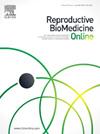Late maturing oocyte rescue in poor-prognosis patients: delayed intracytoplasmic sperm injection results in more viable embryos
IF 3.7
2区 医学
Q1 OBSTETRICS & GYNECOLOGY
引用次数: 0
Abstract
Research question
Can delayed intracytoplasmic sperm injection (DICSI) in late maturing oocytes improve fertilization, blastocyst formation, pregnancy and live birth rates for poor-prognosis patients?
Design
Retrospective analysis of 2243 oocytes from 250 poor-prognosis patients who underwent 311 assisted reproductive technology (ART) cycles. Patients were offered DICSI to increase the number of embryos available for testing when over 50% of oocytes collected were immature on day 0, less than 50% of the injected oocytes were fertilized on day 1 or when patients were undergoing preimplantation genetic testing for aneuploidy.
Results
Fertilization and blastulation rates differed depending on the original assessment of the oocyte maturation stage. Euploidy rate did not differ between blastocysts derived from fertilized oocytes originally assessed as metaphase I (MI) or metaphase II (MII). A transferred blastocyst derived from a matured oocyte originally assessed as MI was as likely to result in a live birth as one from a MII oocyte. No differences in delivery method, gestation period or birth weight were found between intracytoplasmic sperm injection and DICSI. As a result of DICSI, at least 27 cycles (8.7%), which would have otherwise been unproductive, resulted in live births, with five ongoing pregnancies.
Conclusions
Both MI and germinal vesicle oocytes can complete maturation in vitro. Blastocysts produced from these are likely to be chromosomally normal compared with oocytes originally assessed as MII, and result in similar live birth rates. With no differences in birth outcomes, and DICSI increasing overall ART cycle success, this approach has value for poor-prognosis patients.
求助全文
约1分钟内获得全文
求助全文
来源期刊

Reproductive biomedicine online
医学-妇产科学
CiteScore
7.20
自引率
7.50%
发文量
391
审稿时长
50 days
期刊介绍:
Reproductive BioMedicine Online covers the formation, growth and differentiation of the human embryo. It is intended to bring to public attention new research on biological and clinical research on human reproduction and the human embryo including relevant studies on animals. It is published by a group of scientists and clinicians working in these fields of study. Its audience comprises researchers, clinicians, practitioners, academics and patients.
Context:
The period of human embryonic growth covered is between the formation of the primordial germ cells in the fetus until mid-pregnancy. High quality research on lower animals is included if it helps to clarify the human situation. Studies progressing to birth and later are published if they have a direct bearing on events in the earlier stages of pregnancy.
 求助内容:
求助内容: 应助结果提醒方式:
应助结果提醒方式:


